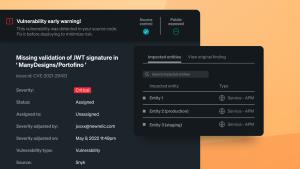These days, virtually every business is a software business, powered and supported by a digital infrastructure. And every business with a digital infrastructure shares three core challenges:
- Operate faster and more efficiently
- Build revenue from its digital transformation projects
- Find new digital opportunities
First of all, if you can’t go fast, you’re simply not going to make it. And if you’re too busy trying to fix problems, you’re not innovating as fast as you need to be. Just as important, in order to maximize revenue, you need to know about any issues before they make a big impact on customer experience and the bottom line. Finally, you need to correctly identify the next most important things to work on: you need to understand what’s most impacting revenues, what’s causing the most customer churn, and so on.
Do it right, we’ve found, and the results can be significant and quantifiable—in everything from TCO to productivity to boosting revenue in multiple areas.
From a break-fix IT model to a proactive technology strategy
Fundamentally, the solution is simple, although it requires a commitment to a new way of thinking about the role of technology. Companies must move beyond the classic break-fix IT model to create a proactive technology administration strategy. With a proactive IT model, you don’t wait for something to break before making improvements. Instead, you work to make the IT ecosystem more predictable by leveraging advanced tools to monitor and diagnose system performance issues against expected outcomes.
At New Relic, we have seen this kind of approach dramatically improve many of our customers’ ability to scale, while slashing long-term technology costs. For example, it’s not uncommon for New Relic customers to experience a 50% decrease in the number of reported service degradation events once they implement a proactive IT management model.
7 ways proactive monitoring can affect the bottom line
Of course, ubiquitous instrumentation and monitoring is a key component of this shift. New Relic is designed to help our customers more easily discern a problem’s point of origin no matter where it is, which can help IT teams diagnose problems faster and more accurately—often before customers ever encounter them.
In fact, we have identified seven key areas where including New Relic in a proactive technology strategy can have a business-value impact on our customers’ bottom line:
- Total cost of ownership
- Human resources productivity
- Infrastructure efficiencies
- E-commerce revenues
- Subscription revenues
- Advertising revenues
- Mobile app adoption and revenues
The first three areas affect nearly all New Relic customers to one degree or another, while the impact of the last four depends on the business and revenue model of the company involved. In practice, though, we often see one or more of this second group applied to a wide variety of business cases, depending on the scope of the New Relic deployment.
1. Total cost of ownership
New Relic has conducted five-year total cost of ownership (TCO) analyses looking at both non-payroll cash flows (checks written to vendors) and a more comprehensive operating-expenses analysis that includes compute, storage, software (operating system, virtualization, controllers, etc.), vendor software, power, space, and human resources. We have also looked at incremental system requirements that are often ignored, like software controllers and the internal human resources required to administrate and support those systems.
This is where New Relic’s multi-tenant approach offers advantages over the architectural complexity of single-tenant deployments, either hosted or on premise. Single-tenant TCO can be unpredictable given the high variability of configurations and deployment models. In multi-tenant deployments—like New Relic—that risk is shifted to the SaaS vendor, making the TCO much easier to predict. While every case is different, we often see a 35% to 50% TCO advantage for New Relic vs. single-tenant alternatives.
2. Human resources productivity
HR productivity may be the most complex factor to calculate, given that it addresses a wide variety of groups, from customer service and tech support to IT ops and dev teams, as well as business analysts who rely on reports detailing application, website, and company performance metrics and need to query that data to do their jobs effectively.
As a rule of thumb, though, we have seen many New Relic customers enjoy a 30% to 40% decrease in system-related customer contacts, with corresponding impacts on HR productivity. Ops and dev engineers, meanwhile, can see a 50% decline in the number of “reported” issues after a New Relic deployment. Time saved for business analysts can vary widely depending on query complexity and data structures, but the impact is rarely zero and can be financially significant in organizations with large numbers of analysts.
3. Infrastructure efficiencies
Infrastructure savings from a proactive IT strategy incorporating New Relic are largely focused on the number of physical servers consolidated when software issues are resolved at their point of origin. In many traditional organizations, service-degradation issues are typically addressed by simply adding additional capacity with more servers. At a sample hardware acquisition cost of $9,700 per server, such physical devices rarely make a huge financial impact. However, the associated software licensing costs tell a different story. Many database and ERP licensing costs are based on the number of server cores upon which those systems run, so adding more servers can quickly escalate software costs.
While your mileage may vary, many of New Relic’s customers experience a 2% to 3% drop in monitored physical server costs, which may not seem significant. But because the annual costs of software running on a single additional server can easily exceed six figures, the savings can turn out to be surprisingly substantial. For example, New Relic conservatively estimates a typical savings of 10% on database licensing fees per core when using this type of approach, which can work out to more than $10,000 a year per server, since you don’t have to pay for software licenses on idle servers.
4. E-commerce revenues
E-commerce revenues can be affected when system-performance problems impact the customer experience, and thus sales-conversion rates. Specifically, slow page-load times and low transaction-completion rates can have a direct impact on conversion rates. For example, many estimates—and our customers’ experiences—suggest that page-load times exceeding 4 seconds can drive away as much as 80% of potential customers. Similarly, we have seen that shopping-cart performance delays and degradations can drive up cart abandonments by as much as 30%.
New Relic helps our customers dramatically reduce the negative effects of errors and delays on e-commerce revenues by making it easy to identify, locate, and address those issues before customers are affected.
5. Subscription revenues
There’s a high correlation between performance and customer acquisition and retention. Revenues from subscription business models are often adversely impacted by attrition when customer acquisitions are affected by service and website performance issues. Even more important, these negative perceptions are often spread and amplified via social media and word-of-mouth.
As part of a proactive technology strategy, New Relic can help customers improve overall system performance, reducing errors and the associated subscriber attrition by as much as 50%.
But that’s not the only benefit. By helping our customers find and fix errors more quickly, New Relic enables them to devote more resources to speeding software iterations and delivering new features and innovations to market more quickly. This can be critical to help subscription businesses avoid losing customers to the competition due to competitive functional deficiencies.
6. Advertising revenues
Not surprisingly, media customers’ advertising revenue models can be directly affected by slow page loads that lead frustrated site visitors to surf elsewhere. Even worse is when ads load much slower than site content, potentially keeping site visitors from ever seeing the ads—and keeping the media company from charging for the ad impression.
Slow load times can also increase bounce rates. Obviously, consumers who bounce away from the site will view fewer pages and see fewer ad impressions, directly affecting ad revenues.
New Relic is designed to help customers monitor and optimize website performance, allowing them to address slow-loading webpages and ads sooner and more efficiently.
7. Mobile app adoption
According to some estimates, boosting an app store star rating from two to four stars increases conversions by a whopping 540%! Similarly, approximately half of potential mobile customers will not download an app with a rating below four stars. Importantly, mobile performance issues, errors, and crashes play a large role in user ratings, which can have huge implications on the bottom line.
One large company, for example, recently experienced errors in nearly 45% of its mobile shopping transactions due to problems with its API calls. The company calculated that these errors translated to some $19 million in lost annual revenue via everything from low app-adoption rates due to poor app store ratings to abandoned mobile shopping carts. Understanding these issues more quickly could have gone a long way toward helping the company minimize this lost revenue.
New Relic is built to help customers address these performance and reliability issues, from quickly identifying problems in real time to locating any underlying architectural and infrastructure issues.
Much more than an application insurance policy
Of course, not all of the economic benefits discussed here drop to the bottom line. Customers still have to invest in the work required to resolve the errors and performance issues New Relic identifies. Nevertheless, it’s easy to see that deploying New Relic as part of a proactive IT strategy can make a big difference to your organization’s bottom line, in a wide variety of ways.
Even more important, though, is that the full benefit of using New Relic is not just monitoring your systems; that’s just an insurance policy, valuable but not necessarily transformational. The real impact of New Relic comes in improving performance to drive revenues and boosting efficiency to drive productivity.
Properly implemented as part of a proactive IT strategy, New Relic is much more than an insurance policy—it’s a strategic and competitive advantage to your digital ecosystem.
The views expressed on this blog are those of the author and do not necessarily reflect the views of New Relic. Any solutions offered by the author are environment-specific and not part of the commercial solutions or support offered by New Relic. Please join us exclusively at the Explorers Hub (discuss.newrelic.com) for questions and support related to this blog post. This blog may contain links to content on third-party sites. By providing such links, New Relic does not adopt, guarantee, approve or endorse the information, views or products available on such sites.



